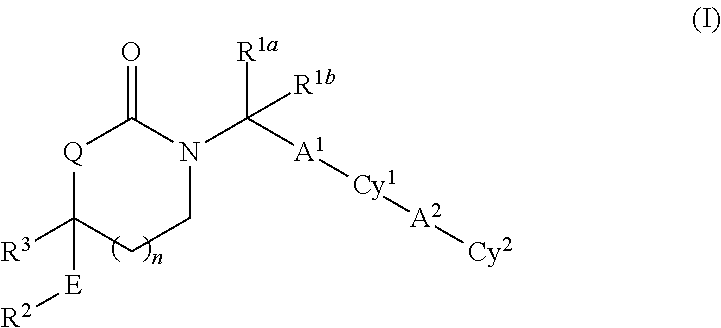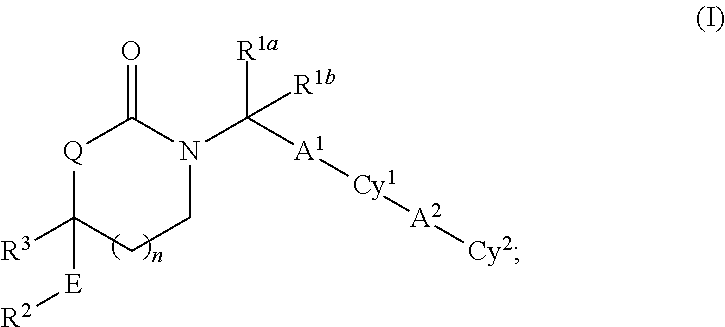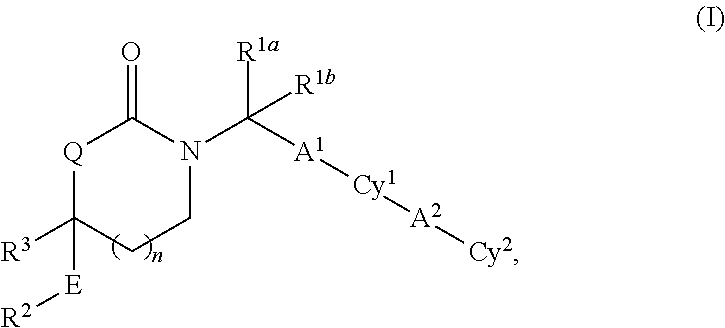Cyclic inhibitors of 11beta-hydroxysteroid dehydrogenase 1
a technology of hydroxysteroid dehydrogenase and cyclic inhibitors, which is applied in the direction of drug compositions, metabolic disorders, cardiovascular disorders, etc., can solve the problems of impaired wound healing, loss of partial visual field and eventually blindness, and adverse effects on skeletal tissues
- Summary
- Abstract
- Description
- Claims
- Application Information
AI Technical Summary
Benefits of technology
Problems solved by technology
Method used
Image
Examples
preparation 1
[0312]
Step 1 (4-Bromo-phenyl)-cyclopropyl-methylamine
[0313]A solution of 4-bromo-benzonitrile (6.30 g) in tetrahydrofuran (50 mL) was added over a period of 20 min to a 0.5 M solution of cyclopropylmagnesium bromide in tetrahydrofuran (200 mL) chilled in an ice bath. After stirring the resulting solution with cooling for 5.5 h, methanol (100 mL) was added over a period of 20 min. Then sodium borohydride (2.65 g) was added portionwise and the resulting mixture was warmed to room temperature overnight. Aqueous saturated NaHCO3 solution was added and then the pH value of the mixture was adjusted to 8-9 using 1 M hydrochloric acid. The resulting mixture was extracted with dichloromethane and the combined extracts were washed with water and dried (MgSO4). The solvent was evaporated to leave an oil that was dissolved in dichloromethane. The resulting solution was extracted with 1 M hydrochloric acid and the combined aqueous extracts were basified (pH value ca. 8-9) with 4 M aqueous NaOH s...
example 1
3-[(4-Bromo-phenyl)-cyclopropyl-methyl]-6-(2-hydroxy-2-methyl-propyl)-6-phenyl-[1,3]oxazinan-2-one (racemic mixture of the diastereomer drawn)
[0323]
[0324]Lithium triethylborohydride (1 mol / L in tetrahydrofuran, 4.9 mL) was added to an ice-cold solution of 3-[(4-bromo-phenyl)-cyclopropyl-methyl]-6-(2-methyl-oxiranylmethyl)-6-phenyl-[1,3]oxazinan-2-one (compound processed from diastereomer 2 obtained in Step 3; 1.86 g, ca. 85-90% pure) in tetrahydrofuran (15 mL) at such a rate that the solution temperature remained below 10° C. The resulting solution was stirred in the cooling bath for one more hour and at room temperature for another 3 h. Then, the solution was cooled in an ice bath and the reaction was quenched by the careful addition of water (7 mL). After the addition of hydrochloric acid and ethyl acetate, the organic phase was separated, washed with brine, and dried (MgSO4). The solvent was evaporated to afford the title compound. Yield: 1.45 g (88% of theory); Mass spectrum (ES...
example 2
3-[(4-Bromo-phenyl)-cyclopropyl-methyl]-6-(2-hydroxy-2-methyl-propyl)-6-phenyl-[1,3]oxazinan-2-one (racemic mixture of the diastereomer drawn)
[0325]
[0326]The title compound was prepared from 3-[(4-bromo-phenyl)-cyclopropyl-methyl]-6-(2-methyl-oxiranylmethyl)-6-phenyl-[1,3]oxazinan-2-one (compound processed from diastereomer 1 obtained in Step 3) following a procedure analogous to that described in Example 1. LC-MS (Method 1): tR=4.01 min; Mass spectrum (ESI+): m / z=458 / 460 (Br) [M+H]+.
PUM
| Property | Measurement | Unit |
|---|---|---|
| temperature | aaaaa | aaaaa |
| temperature | aaaaa | aaaaa |
| temperature | aaaaa | aaaaa |
Abstract
Description
Claims
Application Information
 Login to View More
Login to View More - R&D
- Intellectual Property
- Life Sciences
- Materials
- Tech Scout
- Unparalleled Data Quality
- Higher Quality Content
- 60% Fewer Hallucinations
Browse by: Latest US Patents, China's latest patents, Technical Efficacy Thesaurus, Application Domain, Technology Topic, Popular Technical Reports.
© 2025 PatSnap. All rights reserved.Legal|Privacy policy|Modern Slavery Act Transparency Statement|Sitemap|About US| Contact US: help@patsnap.com



